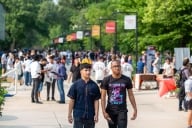You have /5 articles left.
Sign up for a free account or log in.
This past weekend, I attended the Networked Humanities: From Within and Without the University conference. It was, apparently, “the cool place to be” according to Twitter (I archived most of the conference tweets and there’s a neat visual). Now, I’ve never EVER been at the “cool place to be” but really, it was a great conference. One of the aspects I particularly appreciate about digital humanities conferences is their interdisciplinary nature; certainly, rhetoric and composition were well-represented (the conference was organized and sponsored by the Writing, Rhetoric, and Digital Media program), but there were historians, anthropologists, art historians, architects, geographers…it was a humanities conference.
(In case you’re interested, here’s a link to my talk, which is based off of a longer piece I presented at Western in the Fall, including the visuals. Since I had the distinction of going last, I kinda just threw out reading my talk and spoke about this topic for 20 minutes.)
If this post seems a little fragmented and underdeveloped, there’s a reason for that. It’s still too early for me to really process everything that was said at the conference, and my new to-read list is miles longer than it was on Thursday. My favorite presentations, be it how to critically incorporate images in the classroom or debating openness, were the ones that explicitly dealt with pedagogy and classroom practice. Discussing digital ethos, all I could think about was introducing this work to my undergraduate students. This bias is clearly because of my teaching-heavy position, but maybe, just maybe I’m turning out to be more of a critical pedagogue than a traditional scholar. Not that the two are mutually exclusive of course, but unless in my mind I could actively connect what was being said to how I taught, my eyes largely glazed over.
But that’s just me.
I was also really struck by the calls throughout the conference for slow reading, slow theory, and small data (as opposed to Big Data). I was disappointed, then, that I took the pieces about micro-history out of my talk, but I appreciated the provocations to notice more of our ambient environment or to appreciate the “worldings” that surround us. Potentially the most prolific tweeter at the conference, I appreciated the call to look up and look at my surrounding a little more carefully. It’s advice I’m going to try to take to heart, as well as introduce to my students. I try to do that in my peer-driven class, giving them lots of time and getting them to focus on depth instead of breadth, but I think I need to do more of that in my Freshman Writing class.
Mind you, I’m not sure I would like what I see if I take the time to really look at what is going on around me closer to home. What struck me the most is that there are all of these interesting and innovative programs, classes, researchers and teachers, but none of that seems to be happening at my home institution. Why aren’t we doing more things like this? I wondered. Or, perhaps more appropriately, I despaired. To be off the tenure-track, stuck in a never-ending loop of the same class, repeated and formed largely outside of my control, limits the amount of change I can institute. But, I can control the classes that I teach, and this gives me a lot of material to chew on over the summer when I try to make my Freshman Writing class better.
There will probably be more topic or presentation-specific posts in the near future...when I have the time. If I have the time. I think that is what is going to haunt me long after I forget the specifics of this conference is how to take the time. I know I need to slow down. I just don’t know how.





